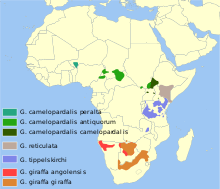Nubian giraffe
| Nubian giraffe | |
|---|---|
| | |
| Nubian giraffes at Al Ain Zoo, United Arab Emirates.[1] | |
| Scientific classification | |
| Kingdom: | Animalia |
| Phylum: | Chordata |
| Clade: | Synapsida |
| Class: | Mammalia |
| Order: | Artiodactyla |
| Family: | Giraffidae |
| Genus: | Giraffa |
| Species: | G. camelopardalis |
| Subspecies: | G. c. camelopardalis |
| Trinomial name | |
| Giraffa camelopardalis camelopardalis (Linnaeus, 1758) | |
 | |
| Range map in dark green | |
| Synonyms | |
|
G.c. rothschildi (Lydekker, 1903) | |
The Nubian giraffe (Giraffa camelopardalis camelopardalis) is the nominate subspecies of northern giraffe native to North Africa. It is found in Ethiopia, Kenya, Uganda, South Sudan and Sudan. It is currently extinct in the wild of the Democratic Republic of Congo, Egypt and Eritrea. The Nubian giraffe used to be widespread everywhere on Northeast Africa. The total population is estimated to 650 original Nubian giraffes.[2] The subspecies is listed as Endangered by the IUCN. The Rothschild's giraffe was once considered a separate subspecies, but after genetic analysis, it has been subsumed as an ecotype into the Nubian giraffe subspecies.[3] Thus, the additional ranges of Kenya and Uganda, with the surplus population of 1500 Rothschild's giraffes in the wild, bolsters the Nubian giraffe significantly.[3]
Physical description
The Nubian giraffe has sharply defined chestnut-colored spots surrounded by mostly white lines, while undersides lack spotting. The median lump is particularly developed in the male giraffe.[4]
Habitat population
Giraffes occurred everywhere in Africa; the Nubian giraffe was widespread throughout North Africa, from Kenya to Egypt. The giraffe lives in savannahs and woodlands. The Nubian giraffe currently lives in eastern South Sudan and southwestern Ethiopia, and isolated pockets in Uganda and Kenya. It was estimated in 2010 that fewer than 250 live in the wild, although this number was uncertain.[5] However, as of 2016, it was recently estimated that 2,150 Nubian giraffes live in the wild, 1500 of those of the Rothschild ecotype.[2]
In captivity
The Nubian giraffe is, due to the introduction of the Rothschild's giraffe into its subspecies, is one of the most common giraffe types present in captivity, in conjunction with the Reticulated giraffe. However, the original phenotype is rare, as the Al Ain Zoo from the United Arab Emirates is the only known zoo outside of Africa to be breeding the endangered original phenotype.[6][7] The Nubian giraffe is also breeding in captivity in Giza Zoo from Egypt.
References
- ↑ "Nubian Giraffe Giraffa camelopardalis camelopardalis" (PDF). 2011. Retrieved 8 July 2015.
- 1 2 Jordan Carlton Schaul (17 June 2014). "Safeguarding Giraffe Populations From Extinction in East Africa". nationalgeographic.com. Retrieved 8 July 2015.
- 1 2 "Multi-locus Analyses Reveal Four Giraffe Species Instead of One". Current Biology. September 8, 2016.
- ↑ Seymour, R. (2002) The taxonomic status of the giraffe, Giraffa camelopardalis (L. 1758), PH.D Thesis
- ↑ "Giraffe – The Facts: Current giraffe status?". Giraffe Conservation Foundation. Retrieved 21 December 2010.
- ↑ "Exhibits". Al Ain Zoo. 25 February 2003. Retrieved 21 November 2011.
- ↑ "Nubian giraffe born in Al Ain zoo". UAE Interact. Retrieved 21 December 2010.
External links
-
 Media related to Nubian Giraffes at Wikimedia Commons
Media related to Nubian Giraffes at Wikimedia Commons -
 Data related to Giraffa camelopardalis camelopardalis at Wikispecies
Data related to Giraffa camelopardalis camelopardalis at Wikispecies
